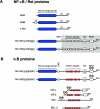Functions of NF-kappaB1 and NF-kappaB2 in immune cell biology
- PMID: 15214841
- PMCID: PMC1133795
- DOI: 10.1042/BJ20040544
Functions of NF-kappaB1 and NF-kappaB2 in immune cell biology
Abstract
Two members of the NF-kappaB (nuclear factor kappaB)/Rel transcription factor family, NF-kappaB1 and NF-kappaB2, are produced as precursor proteins, NF-kappaB1 p105 and NF-kappaB2 p100 respectively. These are proteolytically processed by the proteasome to produce the mature transcription factors NF-kappaB1 p50 and NF-kappaB2 p52. p105 and p100 are known to function additionally as IkappaBs (inhibitors of NF-kappaB), which retain associated NF-kappaB subunits in the cytoplasm of unstimulated cells. The present review focuses on the latest advances in research on the function of NF-kappaB1 and NF-kappaB2 in immune cells. NF-kappaB2 p100 processing has recently been shown to be stimulated by a subset of NF-kappaB inducers, including lymphotoxin-beta, B-cell activating factor and CD40 ligand, via a novel signalling pathway. This promotes the nuclear translocation of p52-containing NF-kappaB dimers, which regulate peripheral lymphoid organogenesis and B-lymphocyte differentiation. Increased p100 processing also contributes to the malignant phenotype of certain T- and B-cell lymphomas. NF-kappaB1 has a distinct function from NF-kappaB2, and is important in controlling lymphocyte and macrophage function in immune and inflammatory responses. In contrast with p100, p105 is constitutively processed to p50. However, after stimulation with agonists, such as tumour necrosis factor-alpha and lipopolysaccharide, p105 is completely degraded by the proteasome. This releases associated p50, which translocates into the nucleus to modulate target gene expression. p105 degradation also liberates the p105-associated MAP kinase (mitogen-activated protein kinase) kinase kinase TPL-2 (tumour progression locus-2), which can then activate the ERK (extracellular-signal-regulated kinase)/MAP kinase cascade. Thus, in addition to its role in NF-kappaB activation, p105 functions as a regulator of MAP kinase signalling.
Figures


 ) and subsequent polyubiquitination (
) and subsequent polyubiquitination ( ) of IκBs, which are then targeted for degradation by the 26 S proteasome. Associated NF-κB dimers are thereby released to translocate into the nucleus, where they bind to the promoter regions of NF-κB-responsive genes to modulate their expression. The transactivating capacity of nuclear NF-κB dimers can also be regulated by phosphorylation.
) of IκBs, which are then targeted for degradation by the 26 S proteasome. Associated NF-κB dimers are thereby released to translocate into the nucleus, where they bind to the promoter regions of NF-κB-responsive genes to modulate their expression. The transactivating capacity of nuclear NF-κB dimers can also be regulated by phosphorylation.



References
-
- Medzhitov R. Toll-like receptors and innate immunity. Nat. Rev. Immunol. 2001;1:135–145. - PubMed
-
- Takeda K., Kaisho T., Akira S. Toll-like receptors. Annu. Rev. Immunol. 2003;21:335–376. - PubMed
-
- O'Neill L. A. J., Dinarello C. A. The IL-1 receptor/Toll-like receptor superfamily: crucial receptors for inflammation and host defense. Immunol. Today. 2000;21:206–209. - PubMed
-
- Wallach D., Varfolomeev E. E., Malinin N. L., Goltsev Y. V., Kovalenko A. V., Boldin M. P. Tumor necrosis factor receptor and Fas signaling mechanisms. Annu. Rev. Immunol. 1999;17:331–367. - PubMed
Publication types
MeSH terms
Substances
LinkOut - more resources
Full Text Sources
Other Literature Sources
Medical
Research Materials
Miscellaneous

